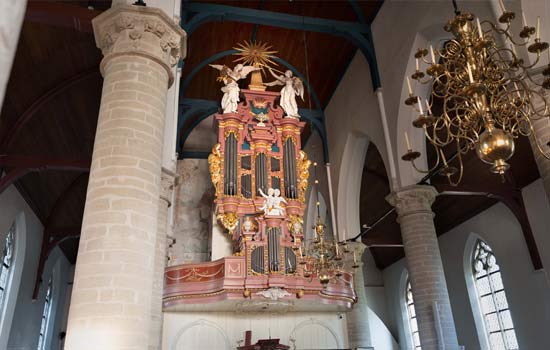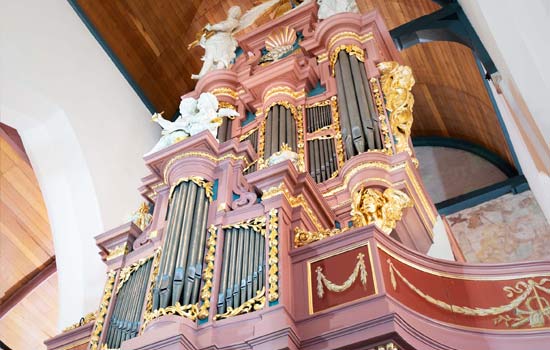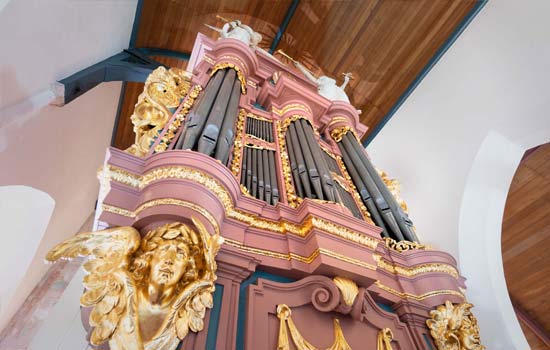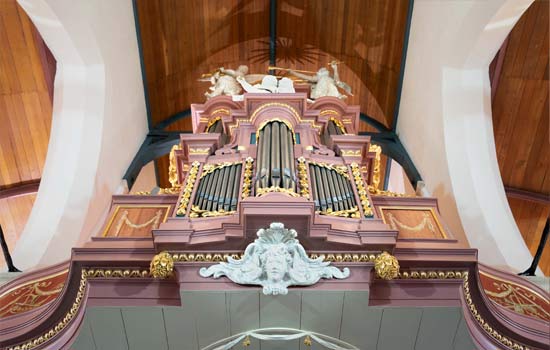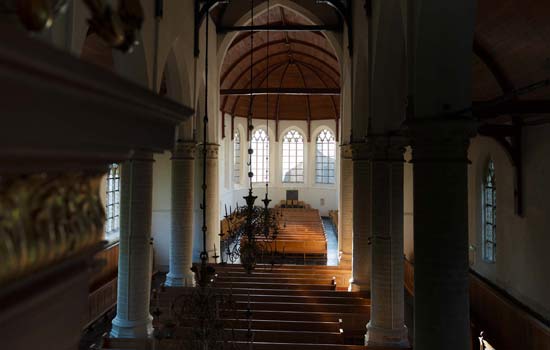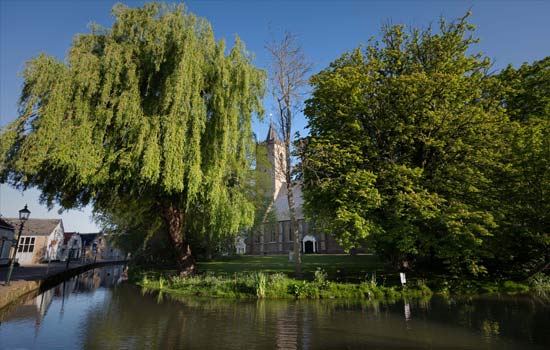Dirksland is a village located on the island of Goeree-Overflakkee in the province of South Holland (Netherlands). The Reformed Church (Hervormde Kerk) of Dirksland stands on a small island surrounded by a canal, right in the centre of the village. It is a three-aisled pseudo-basilica with a 15th-century tower, a choir from the early 16th century, and a nave dating mainly from around 1680.
Inside the church is a beautiful historic organ with a finely crafted façade that reflects its rich historical background. The organ case (kas), built around 1680, originates from the Flemish coastal region and represents a fine example of late 17th-century South Netherlandish organ building. The decorative sculpture was created in the expressive baroque style typical of that region: richly carved angels, cherubs and garlands adorn the case. The main case is crowned by two powerful angels blowing trumpets and the “All-Seeing Eye” of God.
The present instrument was built in 1807–1808 by Johannes Pieter Künckel, who incorporated the older Flemish case into his new organ. The earlier case and part of the pipework likely came from an organ built around 1680, possibly by Jan van Belle or Jacob van Eynde, and later sold via the organ dealer J. Smets from Brussels to Dirksland in 1803.
After installation, the organ was inspected by Pieter Welter (1805), but the instrument was later reworked by Künckel himself. Further improvements followed: in 1809, A. Meere undertook maintenance, and in 1811, Abraham Meere carried out intonation and windchest repairs. Subsequent cleaning and repairs were done by Meere (1825), W.H. Kam (1857), and Schölgens & Van den Haspel (1875), who also re-leathered the bellows. During the following century, the organ underwent several restorations: by Maarschalkerweerd in 1902, by the firm De Koff around 1921 (who also installed a wind motor in 1931/32), and later by Flentrop Orgelbouw, who completed a major restoration in 1971. Further maintenance and restoration were carried out by Flentrop in 2003 and by Elbertse Orgelbouw in 2019, both under the advice of Aart Bergwerff.
The organ’s Cornet stop (in Hoofdwerk) is considered to be the only surviving part of the original Flemish organ — possibly dating back to around 1680 — making it much older than the rest of the instrument. It has also stops, which are characteristic for the organbuilding for this time period: Carillon and Fluittraver (in Rugpositief).
The organ is tuned in Neidhardt’s Grosse Stadt temperament (1724). In the sample set, the original suspended pedal has been expanded with three borrowed pedal stops from the Hoofdwerk: Bourdon 16′, Prestant 8′, and Roerfluit 8′, available in the Simple Jamb view. The keyboard compass was extended in the manuals, from C-f3 (C2-F6) to C-a3 (C2-A6).
Although modest in size, the Dirksland organ offers great musical pleasure and stands as a valuable example of early 19th-century Dutch organ building.
Listening perspectives
Using this audio player you can listen to different audio channels the sample set is made of.
Use the sliders corresponding for each audio group to modify its volume.
Technical details
Order
Choose which version you want to order. If you want to try the demo first, use the Add to cart button close to Demo version label and proceed to the checkout to get the download link. The only limitation of demo versions is the number of available stops. Click Show demo version button under the stoplist to see the available stops.
Updates
No updates have been released so far.

